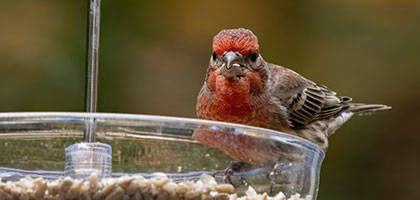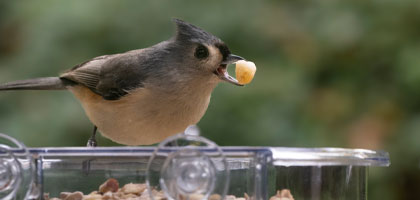Cardinals are a delight to watch. Their vibrant red plumage and melodic songs make them a favorite among bird enthusiasts.
But how do you attract these beautiful birds to your yard? The answer lies in choosing the right bird feeder.
Not all bird feeders are created equal, especially when it comes to cardinals. These birds have specific preferences that need to be considered.
In this guide, we'll explore what makes the best feeder for cardinals. We'll delve into their preferences, the ideal feeder designs, and essential features to look for.
We'll also discuss how to squirrel-proof your feeder and the best placement for attracting cardinals.
By the end, you'll be equipped with the knowledge to choose the perfect cardinal bird feeder enhancing your bird-watching experience.
Understanding Cardinal Preferences
Cardinals prefer feeders with ample space for them to perch comfortably. Unlike some smaller birds, cardinals do not like clinging while eating. They enjoy sturdy perches where they can sit as they dine.
Additionally, cardinals are attracted to feeders that have a wide, flat surface. This is because their natural feeding behavior involves foraging on the ground. Bright colors, particularly reds, can also be alluring to these birds. Ensuring these features are present will make your yard an inviting spot for cardinals to visit regularly.
Top Bird Feeder Designs for Cardinals
Choosing the right bird feeder design is crucial for attracting cardinals. The design must cater to their specific feeding habits and preferences. Let’s explore some of the top bird feeder designs that suit cardinals.
Hopper Feeders
Hopper feeders are highly favored for cardinals. These feeders feature a large compartment to store seeds, providing easy access to cardinals. The wide perching area allows cardinals to comfortably sit as they feed, making it a popular choice among bird enthusiasts. In addition to their functional advantages, hopper feeders often come with roofs that protect seeds from inclement weather.
Platform Feeders
Platform feeders are another excellent choice for cardinals. They offer an open feeding area that suits cardinals' natural inclination to feed on open spaces. Typically elevated, they provide a stable feeding surface, allowing several cardinals to dine simultaneously. However, make sure it has a mesh bottom for drainage to prevent seed spoilage.
Features of a Perfect Cardinal Bird Feeder
When selecting a bird feeder for cardinals, certain features stand out. These elements ensure that cardinals can feed comfortably while the feeder remains durable and efficient over time.
Ample Perching Space
Cardinals love feeders with spacious perches. Ample perching space allows cardinals to feed without hassle, promoting a steady stream of visits. Look for feeders with broad ledges or trays, ensuring multiple cardinals can feed together.
Sturdy and Durable Materials
The materials of a bird feeder are crucial for lasting use. Feeders made from metal or heavy-duty plastic withstand cardinals' strong beaks and harsh weather. Durability ensures the feeder remains safe and functional, providing consistent feeding opportunities.
Weather Protection
Protecting seeds from the elements is essential. A feeder with a roof or cover safeguards seeds from rain and snow. This feature not only preserves the seed's quality but also provides cardinals with sheltered feeding during adverse weather. Choosing the right features enhances the feeder's performance, making your space a welcoming haven for these beautiful birds.
Squirrel Proofing: A Must for Cardinal Feeders
Squirrels can be notorious pests when it comes to bird feeders. They often outsmart basic designs, quickly devouring seeds meant for cardinals. For bird enthusiasts, squirrel-proofing features are essential in a bird feeder.
These features include weight-activated mechanisms that close off access when squirrels land on the feeder. Locking lids can prevent squirrels from raiding the seed supply. Choosing feeders with these deterrents ensures that your seeds remain reserved for cardinals. Protecting your feeder from squirrels not only preserves the seed but also keeps cardinals visiting your garden regularly.
Cardinal-Friendly Feeder Placement
Where you place your cardinal bird feeder can significantly impact its success. Cardinals prefer locations that are quiet and calm. They thrive in areas where they can feed without frequent disturbances.
Position the feeder about five to six feet off the ground. This height provides safety from predators like cats. Ensure the feeder is away from busy areas, such as roads or footpaths, to create a secure environment for the birds. A location with natural cover, like nearby shrubs or trees, can also offer cardinals a sense of protection. Placing your feeder thoughtfully encourages cardinals to visit your yard consistently.
Seed Selection to Attract Cardinals
Choosing the right seeds can make a difference in attracting cardinals to your feeder. Cardinals are particularly fond of certain seeds, which are not only nutritious but also easy for them to eat with their strong beaks.
Consider offering a mix of seeds to cater to cardinals' preferences. Here are two popular options for filling your cardinal bird feeder:
- Safflower Seeds: These seeds are less appealing to squirrels but loved by cardinals. Their bitter taste deters other unwanted guests.
- Black Oil Sunflower Seeds: High in oil content, these seeds are nutritious and provide the energy cardinals need.
By selecting these types of seeds, you create an inviting dining experience for cardinals in your garden.
Maintenance and Hygiene: Keeping Your Bird Feeder Cardinal-Friendly
Keeping your bird feeder clean is vital for the health of your visiting cardinals. A clean feeder prevents the spread of diseases and ensures a steady flow of fresh seeds. Regular cleaning also discourages mold growth, which can spoil seeds and deter cardinals.
To maintain hygiene, disassemble the feeder and wash it with a mild soap and water solution. Allow it to dry fully before adding seeds. This simple yet crucial routine helps ensure a clean and healthy eating environment for your feathered friends. Regular maintenance keeps your feeder inviting for cardinals all year round.
Additional Tips to Attract and Retain Cardinals
Creating an ideal environment for cardinals involves more than just choosing the right feeder. Providing a nearby water source enhances your yard's appeal, as cardinals enjoy bathing and drinking water. A small bird bath placed close to the feeder can make your yard even more inviting.
To keep cardinals coming back, ensure your feeder is consistently filled with fresh seeds. This consistent nourishment encourages cardinals to visit repeatedly and depend on your garden for sustenance. Additionally, place your feeder in a safe, quiet location. Position it away from potential threats like predators and human activity.
Here are a few more helpful tips:
- Providing Water Sources
- Regular Feeder Refilling
- Safe Feeder Location
By keeping these factors in mind, your garden can become a haven for these vibrant birds. Attracting and keeping cardinals around is a rewarding experience for any bird enthusiast.
Conclusion: Making the Right Choice for Your Feathered Friends
Selecting the best bird feeder involves several important considerations. By focusing on appropriate feeder designs, such as hopper or platform feeders, you can provide a comfortable feeding environment for cardinals. Ensuring the feeder is durable, offers weather protection, and deters squirrels will keep your feathered friends safe and well-fed.
In addition to choosing a suitable feeder, remember the importance of proper placement and food selection. Creating a safe, inviting habitat with fresh seeds and a nearby water source enhances the appeal of your yard. With these tips in mind, you can enjoy the beauty and presence of cardinals all year round. Your careful attention will provide cardinals with a nurturing space to thrive, making your garden a lively focal point for avian life.




